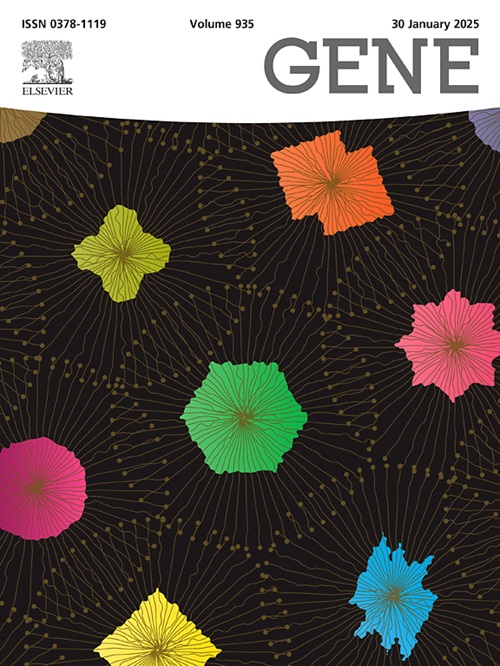BZW2 is a potential regulator of non-small cell lung cancer progression
IF 2.6
3区 生物学
Q2 GENETICS & HEREDITY
引用次数: 0
Abstract
Background
Personalized targeted therapy has become an important strategy for cancer treatment owing to its remarkable therapeutic efficacy and safety. However, drug resistance remains the primary cause of treatment failure. Basic leucine zipper and W2 domain 2 (BZW2), which is aberrantly expressed in cancer, has been implicated in tumor progression and may serve as a new therapeutic target. Therefore, the role of BZW2 in non-small cell lung cancer (NSCLC) requires further investigation.
Methods
The expression and genetic alterations of BZW2 in pan-cancers were explored using The Cancer Genome Atlas (TCGA) PanCancer databases. The mRNA and protein levels of BZW2 in patients with NSCLC were verified in our cohort. Functional experiments including CCK8, colony formation, and transwell assays were performed to evaluate the impact of BZW2 on the proliferative, migratory, and invasive capacities of SK-MES-1 cells. Gene Set Enrichment Analysis was used to identify underlying biological processes and pathways. Single-cell RNA (scRNA) sequencing data were employed to investigate the tumor microenvironment of NSCLC and the co-expression of BZW2 and stemness-related genes.
Results
Dysregulated BZW2 expression was observed in various malignant tumors. BZW2 expression was found to be significantly elevated in NSCLC. BZW2 depletion inhibited the growth, mobility, and invasive abilities of lung squamous cell carcinoma SK-MES-1 cells. BZW2 may be related to signaling pathways such as nucleotide excision repair, ubiquitin-mediated proteolysis, and the P53 signaling pathway. Biological processes, including translational initiation, tRNA processing, and RNA methylation, were observed to be enriched in the high-BZW2 group. Furthermore, there was a positive correlation between BZW2 and the m6A- and m5C-related genes. scRNA analysis revealed a co-expression relationship between BZW2 and stemness-related genes such as CD44, SOX9, and CD133.
Conclusions
Elevated BZW2 expression is associated with the proliferation, migration, and invasion of NSCLC, and BZW2 may be a potential therapeutic target for NSCLC.
BZW2 是非小细胞肺癌进展的潜在调控因子。
背景:个性化靶向治疗因其显著的疗效和安全性已成为癌症治疗的重要策略。然而,耐药性仍然是治疗失败的主要原因。在癌症中异常表达的碱性亮氨酸拉链和W2结构域2(BZW2)被认为与肿瘤进展有关,可作为新的治疗靶点。因此,BZW2在非小细胞肺癌(NSCLC)中的作用需要进一步研究:方法:利用癌症基因组图谱(TCGA)泛癌数据库探讨了BZW2在泛癌中的表达和基因改变。在我们的队列中,BZW2在NSCLC患者中的mRNA和蛋白水平得到了验证。为了评估BZW2对SK-MES-1细胞的增殖、迁移和侵袭能力的影响,我们进行了包括CCK8、集落形成和透孔实验在内的功能实验。基因组富集分析(Gene Set Enrichment Analysis)用于确定潜在的生物过程和通路。利用单细胞RNA(scRNA)测序数据研究了NSCLC的肿瘤微环境以及BZW2和干细胞相关基因的共表达:结果:在各种恶性肿瘤中都观察到了BZW2的表达失调。结果:在多种恶性肿瘤中都观察到了BZW2表达失调的现象,发现BZW2在NSCLC中表达明显升高。抑制BZW2可抑制肺鳞癌SK-MES-1细胞的生长、移动和侵袭能力。BZW2 可能与核苷酸切除修复、泛素介导的蛋白水解和 P53 信号通路等信号通路有关。据观察,高BZW2组富集了包括翻译启动、tRNA加工和RNA甲基化在内的生物过程。scRNA分析显示,BZW2与CD44、SOX9和CD133等干性相关基因之间存在共表达关系:结论:BZW2表达升高与NSCLC的增殖、迁移和侵袭有关,BZW2可能是NSCLC的潜在治疗靶点。
本文章由计算机程序翻译,如有差异,请以英文原文为准。
求助全文
约1分钟内获得全文
求助全文
来源期刊

Gene
生物-遗传学
CiteScore
6.10
自引率
2.90%
发文量
718
审稿时长
42 days
期刊介绍:
Gene publishes papers that focus on the regulation, expression, function and evolution of genes in all biological contexts, including all prokaryotic and eukaryotic organisms, as well as viruses.
 求助内容:
求助内容: 应助结果提醒方式:
应助结果提醒方式:


